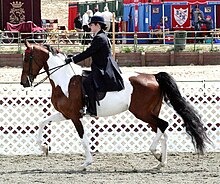Crossbreed
This article needs additional citations for verification. (January 2011) |

A crossbreed or crossbred usually refers to an organism with purebred parents of two different breeds, varieties, or populations. Crossbreeding, sometimes called "designer crossbreeding", refers to the process of breeding such an organism, often with the intention to create offspring that share the traits of both parent lineages, or producing an organism with hybrid vigor. While crossbreeding is used to maintain health and viability of organisms, irresponsible crossbreeding can also produce organisms of inferior quality or dilute a purebred gene pool to the point of extinction of a given breed of organism.[citation needed]
The term is also used at times to refer to a domestic animal of unknown ancestry where the breed status of only one parent or grandparent is known, though the term "mixed breed" is technically more accurate. The term outcross is used to describe a type of crossbreeding used within a purebred breed to increase the genetic diversity within the breed, particularly when there is a need to avoid inbreeding.
In animal breeding, crossbreed describes crosses within a single species, while hybrid refers to crosses between different species. In plant breeding terminology, the term crossbreed is uncommon. No universal term is used to distinguish hybridization or crossing within a population from those between populations, or even those between species.
Crossbreeds in specific animals
Cattle
In cattle, there are systems of crossbreeding. In many crossbreeds, one is larger than the other. One is used when the purebred females are particularly adapted to a specific environment, and are crossed with purebred bulls from another environment to produce a generation having traits of both parents.[1]
Sheep
The large number of breeds of sheep, which vary greatly, creates an opportunity for crossbreeding to be used to tailor production of lambs to the goal of the individual stockman.[2]
Llamas
Results of crossbreeding classic and woolly breeds of llama are unpredictable. The resulting offspring displays physical characteristics of either parent, or a mix of characteristics from both, periodically producing a fleeced llama. The results are increasingly unpredictable when both parents are crossbreeds, with possibility of the offspring displaying characteristics of a grandparent, not obvious in either parent. [3]
Dogs
A crossbred dog is a cross between two (sometimes more) known breeds, and is usually distinguished from a mixed-breed dog, which has ancestry from many sources, some of which may not be known. Crossbreeds are popular, due to the belief that they have increased vigor without loss of attractiveness of the dog. Certain planned crossbreeding between purebred dogs of different breeds can produce puppies worth more than their purebred parents, due to a high demand.[citation needed]
Horses

Crossbreeding in horses is often done with the intent of ultimately creating a new breed of horse. One type of modern crossbreeding in horses is used to create many of the warmblood breeds. Warmbloods are a type of horse used in the sport horse disciplines, usually registered in an open stud book by a studbook selection procedure that evaluates conformation, pedigree and, in some animals, a training or performance standard. Most warmblood breeds began as a cross of draft horse breeds on Thoroughbreds, but have, in some cases, developed over the past century to the point where they are considered to be a true-breeding population and have a closed stud book. Other types of recognized crossbreeding include that within the American Quarter Horse, which will register horses with one Thoroughbred parent and one registered Quarter Horse parent in the "Appendix" registry, and allow such animals full breed registration status as Quarter Horses if they meet a certain performance standard. Another well-known crossbred horse is the Anglo-Arabian, which may be produced by a purebred Arabian horse crossed on a Thoroughbred, or by various crosses of Anglo-Arabians with other Anglo-Arabians, as long as the ensuing animal never has more than 75% or less than 25% of each breed represented in its pedigree.
Hybrid animals
A hybrid animal is one with parentage of two separate species, differentiating it from crossbred animals, which have parentage of the same species. Hybrids are usually, but not always, sterile.[4]
One of the most ancient types of hybrid animal is the mule, a cross between a female horse and a male donkey. The liger is a hybrid cross between a male lion and female tiger. The yattle is a cross between a cow and a yak. Other crosses include the tigon (between a male tiger and female lion) and yakalo (between a yak and buffalo). The Incas recognized that hybrids of Lama glama (llama) and Lama pacos (alpaca) resulted in a hybrid with none of the advantages of either parent.[5]
At one time it was thought that dogs and wolves were separate species, and the crosses between dogs and wolves were called wolf hybrids. Today wolves and dogs are both recognized as Canis lupus, but the old term "wolf hybrid" is still used.
Mixed breeds
A mixed-breed animal is defined as having undocumented or unknown parentage, while a crossbreed generally has known, usually purebred parents of two distinct breeds or varieties. A dog of unknown parentage is often called a mixed-breed dog, "mutt" or "mongrel." A cat of unknown parentage is often referred to as domestic short-haired or domestic long-haired cat generically, and in some dialects is often called a "moggy". A horse of unknown bloodlines is a grade horse.
See also
References
- ^ Cross breeding systems for beef cattle larger Department of Primary Industries and Fisheries, Queensland
- ^ Crossbreeding In Sheep, by Angie Bailey, Jason Canup and Jorge Lucena Purdue University, USA
- ^ What is a classic llama?
- ^ Why Are Hybrids Sterile ? - Because of gene evolution
- ^ An Ancient Livestock, by Barbara Lang
